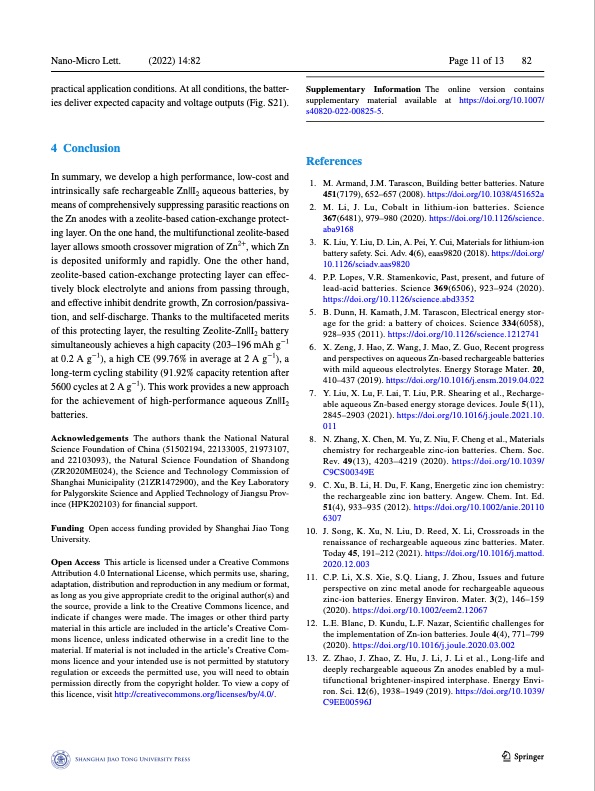
PDF Publication Title:
Text from PDF Page: 011
Nano-Micro Lett. (2022) 14:82 practicalapplicationconditions.Atallconditions,thebatter- ies deliver expected capacity and voltage outputs (Fig. S21). 4 Conclusion In summary, we develop a high performance, low-cost and intrinsically safe rechargeable Zn||I2 aqueous batteries, by means of comprehensively suppressing parasitic reactions on the Zn anodes with a zeolite-based cation-exchange protect- ing layer. On the one hand, the multifunctional zeolite-based layer allows smooth crossover migration of Zn2+, which Zn is deposited uniformly and rapidly. One the other hand, zeolite-based cation-exchange protecting layer can effec- tively block electrolyte and anions from passing through, and effective inhibit dendrite growth, Zn corrosion/passiva- tion, and self-discharge. Thanks to the multifaceted merits of this protecting layer, the resulting Zeolite-Zn||I battery at 0.2 A g−1), a high CE (99.76% in average at 2 A g−1), a long-term cycling stability (91.92% capacity retention after 5600 cycles at 2 A g−1). This work provides a new approach for the achievement of high-performance aqueous Zn||I batteries. Acknowledgements The authors thank the National Natural Science Foundation of China (51502194, 22133005, 21973107, and 22103093), the Natural Science Foundation of Shandong (ZR2020ME024), the Science and Technology Commission of Shanghai Municipality (21ZR1472900), and the Key Laboratory for Palygorskite Science and Applied Technology of Jiangsu Prov- ince (HPK202103) for financial support. Funding Open access funding provided by Shanghai Jiao Tong University. Open Access This article is licensed under a Creative Commons Attribution 4.0 International License, which permits use, sharing, adaptation, distribution and reproduction in any medium or format, as long as you give appropriate credit to the original author(s) and the source, provide a link to the Creative Commons licence, and indicate if changes were made. The images or other third party material in this article are included in the article’s Creative Com- mons licence, unless indicated otherwise in a credit line to the material. If material is not included in the article’s Creative Com- mons licence and your intended use is not permitted by statutory regulation or exceeds the permitted use, you will need to obtain permission directly from the copyright holder. To view a copy of this licence, visit http://creativecommons.org/licenses/by/4.0/. Page 11 of 13 82 Supplementary Information The online version contains supplementary material available at https://doi.org/10.1007/ s40820-022-00825-5. References 1. M. Armand, J.M. Tarascon, Building better batteries. Nature 451(7179), 652–657 (2008). https://doi.org/10.1038/451652a 2. M. Li, J. Lu, Cobalt in lithium-ion batteries. Science 367(6481), 979–980 (2020). https://doi.org/10.1126/science. aba9168 3. K. Liu, Y. Liu, D. Lin, A. Pei, Y. Cui, Materials for lithium-ion battery safety. Sci. Adv. 4(6), eaas9820 (2018). https://doi.org/ 10.1126/sciadv.aas9820 4. P.P. Lopes, V.R. Stamenkovic, Past, present, and future of lead-acid batteries. Science 369(6506), 923–924 (2020). https://doi.org/10.1126/science.abd3352 5. B. Dunn, H. Kamath, J.M. Tarascon, Electrical energy stor- age for the grid: a battery of choices. Science 334(6058), 928–935 (2011). https://doi.org/10.1126/science.1212741 6. X. Zeng, J. Hao, Z. Wang, J. Mao, Z. Guo, Recent progress and perspectives on aqueous Zn-based rechargeable batteries with mild aqueous electrolytes. Energy Storage Mater. 20, 410–437 (2019). https://doi.org/10.1016/j.ensm.2019.04.022 7. Y. Liu, X. Lu, F. Lai, T. Liu, P.R. Shearing et al., Recharge- able aqueous Zn-based energy storage devices. Joule 5(11), 2845–2903 (2021). https://doi.org/10.1016/j.joule.2021.10. 011 8. N. Zhang, X. Chen, M. Yu, Z. Niu, F. Cheng et al., Materials chemistry for rechargeable zinc-ion batteries. Chem. Soc. Rev. 49(13), 4203–4219 (2020). https://doi.org/10.1039/ C9CS00349E 9. C. Xu, B. Li, H. Du, F. Kang, Energetic zinc ion chemistry: the rechargeable zinc ion battery. Angew. Chem. Int. Ed. 51(4), 933–935 (2012). https://doi.org/10.1002/anie.20110 6307 10. J. Song, K. Xu, N. Liu, D. Reed, X. Li, Crossroads in the renaissance of rechargeable aqueous zinc batteries. Mater. Today 45, 191–212 (2021). https://doi.org/10.1016/j.mattod. 2020.12.003 11. C.P. Li, X.S. Xie, S.Q. Liang, J. Zhou, Issues and future perspective on zinc metal anode for rechargeable aqueous zinc-ion batteries. Energy Environ. Mater. 3(2), 146–159 (2020). https://doi.org/10.1002/eem2.12067 12. L.E. Blanc, D. Kundu, L.F. Nazar, Scientific challenges for the implementation of Zn-ion batteries. Joule 4(4), 771–799 (2020). https://doi.org/10.1016/j.joule.2020.03.002 13. Z. Zhao, J. Zhao, Z. Hu, J. Li, J. Li et al., Long-life and deeply rechargeable aqueous Zn anodes enabled by a mul- tifunctional brightener-inspired interphase. Energy Envi- ron. Sci. 12(6), 1938–1949 (2019). https://doi.org/10.1039/ C9EE00596J 2−1 simultaneously achieves a high capacity (203–196 mAh g 2 13PDF Image | Boosting Zn Battery by Coating a Zeolite‐Based Cation‐Exchange

PDF Search Title:
Boosting Zn Battery by Coating a Zeolite‐Based Cation‐ExchangeOriginal File Name Searched:
Shang2022_ZnI-Battery.pdfDIY PDF Search: Google It | Yahoo | Bing
CO2 Organic Rankine Cycle Experimenter Platform The supercritical CO2 phase change system is both a heat pump and organic rankine cycle which can be used for those purposes and as a supercritical extractor for advanced subcritical and supercritical extraction technology. Uses include producing nanoparticles, precious metal CO2 extraction, lithium battery recycling, and other applications... More Info
Heat Pumps CO2 ORC Heat Pump System Platform More Info
| CONTACT TEL: 608-238-6001 Email: greg@infinityturbine.com | RSS | AMP |